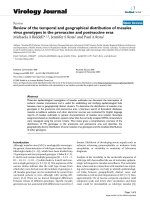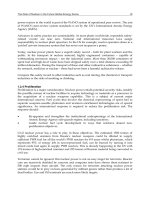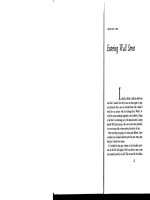Ozren Ocic Oil Refineries in the 21st CenturyOil phần 2 pdf
Bạn đang xem bản rút gọn của tài liệu. Xem và tải ngay bản đầy đủ của tài liệu tại đây (132.56 KB, 15 trang )
Former simple calculations, based on estimated direct and fixed costs, which were
added in full amounts, nowadays have been changed by ascertaining the calculating
costs based on accounting data, as well as by determining the fixed costs in terms of a
relevant index, and not in full as up to that period.
Pushing for profit has been the reason for substantial development in cost calcula-
tion. It became obvious that distinctive calculation methods had to be defined for
different companies and dissimilar industrial branches. The causative principle
also has to be followed, as well as the connection between the charges per places
of costs, and the charges per cost bearers, namely all that in relation to the extent
of costs incurred by a particular product.
The next step in calculation advances was the defining of the standards for costs per
product on a scientific basis. In many industrial activities such a procedure enables
precise assessment of direct costs, while fixed costs have to be ascribed to the cost
bearers and products by relevant keys observing corresponding causalities.
The biggest problem in process technology, in terms of the business-management
procedures, is the fact that this process consists of specific manufacturing operations,
marked by finishing of coupled products. Therefore, considering the existing econom-
ic and financial instruments, it could be concluded that the efficiency management in
process technology is to a great extent limited. This fact calls for the improvement of
the existing criteria of business efficiency, as well as for research in new assessment
methods.
Efficiency management in process technology for increasing the profit and mini-
mizing the process expenses is linked to the prerequisite of defining the cost calcula-
tions, and their comparison to the selling prices in the market.
Calculation as an instrument of business policy is especially important in process
technology, because there is no direct way of charging the expenditures to the cost
bearers. Therefore direct linking of the costs is not possible in the case of feedstock
or in other calculation elements.
The main reason lies in the fact that this is a process industry where a full slate of
products, differing in quality and by use value, is obtained from a single feedstock on a
single unit. Relating the basic feedstock costs to all products, and observing their in-
dividual quality as obtained on a particular processing unit, does not, in fact, present
the real causality of costs for a single product. All the products cannot be evenly treated
from the aspect of production motive. Namely, within a product slate we can recognize
the products, on account of which the production process is organized, as well as by-
products, which are inevitable, in a process. These products must not be treated in the
same way from the aspect of charging the costs to their carriers.
The existing methods for cost calculations are the most convenient for processes
without coupled production. Cost calculations in such processes are easy proce-
dures, because ascribing the direct expenditures to the cost bearers is simple, whereas
overhead and common expenses are distributed by corresponding keys to the cost
bearers.
In the case of coupled products, both direct and indirect charges should be ascribed
to the cost bearers by corresponding keys, for instance in the chemical industry, sugar
industry, petroleum processing, thermoelectric-power production, etc. In these indus-
2.1 Possibilities for Process-Efficiency Management Based on Existing Economic 77
try branches, the elective division calculation with equivalent numbers should be used.
So far, such accounting has existed only in theory but not in practice, especially in
petroleum refining. Subsequent chapters of this book will depict exactly the possibi-
lities of applying these calculations to practice.
2.2
Importance of Energy for Crude-Oil Processing in Oil Refineries
A large amount of energy is used in oil refineries for crude-oil processing.
A refinery itself can ensure all the utilities required for its operation by means of
more or less complex energy transformations, using a part of the products obtained by
crude-oil processing. Therefore, crude oil for a refinery presents not only a feedstock,
but also the main source of energy, required for crude-oil processing. This fact aggra-
vates a clear separation of a refinery-utilities system from crude-oil processing.
On the other hand, this fact ensures that the energy-consumption level, i.e., energy-
utilization efficiency in crude-oil processing can be presented by a special indicator, i.e.
by the inlet crude-oil amount used by a refinery for its own energy requirements in
crude-oil processing. A proportional part of “energy” consumption of crude oil in the
total quantity of crude-oil processed is usually observed as an indicator.
Today, in oil refineries, the share of crude oil used for energy generation is in the
range of 4 % to 8 %, depending on the refinery complexity level. Complexity, i.e. “a
depth of crude-oil processing” is increased as the range of products and the number
of so-called secondary units is enlarged” [6].
The level of energy requirements in an oil refinery, is increased by the level of com-
plexity and it is expressed as follows:
– As the share of energy consumption in total quantity of crude-oil processed, or
– As a specific energy consumption per tonne of processed crude oil, or per tonne of
generated refinery products.
The dependence of specific energy consumption on complexity level and oil refinery
efficiency is shown in Fig. 1, taking 28 US refineries as examples.
It can be clearly seen that the level of energy requirements is increased by the level of
complexity and that the oil refineries with the same level of complexity can have low
and high level of energy efficiency [7]. The difference between energy-efficient oil
refineries (line b), and energy-inefficient oil refineries (line a), is a real possibility
for rationalization of the energy consumption in energy-inefficient refineries. Ineffi-
cient refineries can decrease their internal energy consumption by 20–30% by using
more efficient technological, energy and organizational solutions. These percentages
are not small, considering the share of energy costs in total costs of crude-oil proces-
sing. This can be illustrated in the following manner: a refinery whose share of crude-
oil energy consumption is 5 %, must operate 16 days/y to meet its own energy require-
ments.
2 Technological and Energy Characteristics of the Chemical Process Industry8
Namely, the good possibilities for rationalization of energy consumption exist be-
cause existing refineries were built in the time when energy was cheap, and when the
investors did not devote much attention to the costs of energy. For that purpose, world-
leading oil companies carried out rationalization [8] and suggested energy-saving pro-
grammes in the 1970s. These energy-saving programmes consist of the following
actions:
– Continuous monitoring of energy costs,
– Identifying the places of irrational energy consumption and preparing the energy-
saving project,
– Modernization of equipment and introduction of computer management,
– Reconstruction of existing equipment and intensification of the maintenance pro-
cess,
– Arranging continuous professional training of operators and increasing the moti-
vation and responsibilities of employees,
– Improvement of process management and direct engagement in rationalization of
energy consumption, etc.
The first results of these energy-conservation programmes were obtained in the
1970s: energy costs were decreased by 7.8 % in 1974 and by 8.9 % in 1975, as com-
pared to 1972 when the energy-conservation programme was implemented.
Fig. 1 Dependence of specific energy consumption on the level of
complexity and efficiency, taking 28 US oil refineries as examples
2.2 Importance of Energy for Crude-Oil Processing in Oil Refineries 99
The process of energy-consumption rationalization is still underway: in the West, it
has already reached a more complex and sophisticated level, while in other countries, it
is still in the elementary, initial phase.
NOTE: The amount of utilities spent per process, as well as the amount of some
process losses is based on the values that are measured in oil refineries
from South-East Europe.
The target standards for comparing the energy consumption of an analysed
typical oil refinery present the average standards of energy consumption in
European refineries.
2 Technological and Energy Characteristics of the Chemical Process Industry10
3
Techno-economic Aspects of Efficiency
and Effectiveness of an Oil Refinery
As an example, techno-economic aspects of efficiency and effectiveness of crude-oil
processing are analysed in a typical 5 million t/y refinery that consists of the following
units: crude unit, vacuum-distillation unit, vacuum-residue visbreaking unit, bitumen,
catalytic reforming, catalytic cracking, gas concentration unit, hydrodesulfurization of
jet fuel and gas oil and alkylation.
The efficiency, expressed as the input/output ratio, is analysed on each refinery unit
separately, from the energy and processing aspects, and the effectiveness, as a value of
output, is analysed taking the refinery complex as an example, from the energy and
processing aspects, as well.
From the aspect of energy, the efficiency is determined as the input/output ratio, i.e.
as a relation of used resources and realized production, through the costs and use of
products in the following manner:
*
Through the costs, by determining the cost prices of high-, medium- and low-pres-
sure steam generated in some refinery units and that are expressed in the following
manner:
Costs of steam generation ðin US$=tÞ
Quantity of produced steam ðin tonnesÞ
For example, the cost price of medium-pressure steam (MpS) produced in the va-
cuum-distillation unit is 0.44 US$/t and it is determined in the following manner:
74636 US$
170000 t
¼ 0:44US=t
*
Through the consumption, by determining specific steam consumption per tonne
of feed, which is expressed as follows:
Steam consumption ðin kgÞ
Feed ðin tonnesÞ
or
MJ
t of feed
For example, the specific gross medium-pressure-steam consumption in relation to
the quantity of light residue, on a vacuum-distillation unit is calculated as follows:
Oil Refineries. O. Ocic
Copyright ª 2005 WILEY-VCH Verlag GmbH & Co. KGaA, Weinheim
ISBN: 3-527-31194-7
1111
89 kg steam
t of feed
or 266:1
MJ
t of feed
*
Also, through the consumption, energy efficiency is determined by the
(in)efficiency index and by comparing the net consumption energy objective stan-
dards that present, in this case, the average energy consumption standards of Wes-
tern European refineries and specific energy consumption of a typical oil refinery
being analysed and is expressed as follows:
Specific net energy consumption ðMJ=tÞ
Objective net energy consumption standard ðin MJ=tÞ
For example, the (in)efficiency index of the vacuum-distillation unit is 140 %, and it
is calculated in the following manner:
1095:5MJ=t
800:0MJ=t
¼ 140 %
From the aspect of energy, the effectiveness is determined through the money savings
that can be achieved by eliminating the cause of inefficiency, i.e. by eliminating differ-
ences between the objective energy consumption standard and internal energy con-
sumption of the mentioned refinery units, and is expressed in the following manner:
Quantity of feed (in tonnes) Â difference in objective and internal consumption (US$/t)
For example, the money savings that can be achieved on vacuum-distillation unit, if
certain measures are taken to eliminate the difference between the objective energy
consumption standard and internal energy consumption, is 1 273 239 US$. This
amount has been determined in the following manner:
2122065 t  0:60 US$=t ¼ 1273239 US$=t
From the aspect of the process, the efficiency is determined as the input/output
ratio, i.e. as the ratio of the used resources and achieved production, through the
cost prices of refinery products that are produced in the refinery units, as semi-pro-
ducts to be blended into market-intended products.
The efficiency of the process is expressed through the costs in the following manner:
Production costs of refinery products ðin US$Þ
Quantity of produced refinery products ðin tonnesÞ
For example, the cost price of a product named vacuum gas oil that is produced on a
vacuum-distillation unit is 190.56 US$/t, and it is determined in the following way:
3 Techno-economic Aspects of Efficiency and Effectiveness of an Oil Refinery12
48873966 US$
256477:8t
¼ 190:56 US$=t
From the same aspect, the effectiveness of an oil refinery, as an output value in the
market, is determined through calculations of the product cost prices, by calculating
the profit or loss for each individual oil product. Profit or loss is calculated as the
difference between the selling price and cost price,
Selling price À cost price ¼ profit or loss
For example, the profit of 26.19 US$/t that is made by production of propane is cal-
culated in the following manner:
254:60 US$=t À 228:41 US$=t ¼ 26:19 US$=t
Considering that the efficiency is observed on the level of smaller organizational
parts, i.e. on the level of refinery units, and the effectiveness on the level of refin-
ery, as a whole, it can be concluded that the efficiency is mainly in the competence
of the operative management and the effectiveness in the competence of strategic
management.
3.1
Techno-economic Aspects of Energy Efficiency and Effectiveness in an Oil Refinery
Energy efficiency is analysed taking an oil refinery complex as an example, which
consists of the following refinery units: crude unit, vacuum-distillation unit, vacuum-
residue visbreaking unit, bitumen, catalytic reforming, catalytic cracking, gas concen-
tration unit, hydrodesulfurization of jet fuel and gas oil, and alkylation.
From the aspect of costs, the energy efficiency is analysed through cost prices of
high-, medium- and low-pressure steam produced in some of the mentioned refinery
units, and from the aspect of consumption, the efficiency is analysed by determining
the specific steam consumption per tonne of feed, as well as by determining the
(in)efficiency index that is calculated by comparing the net energy consumption ob-
jective standards (average energy consumption standards of Western European refi-
neries) and specific energy consumption in the units of a typical oil refinery being
analysed.
Energy effectiveness is determined on the basis of the money savings that can be
achieved by eliminating the differences between objective energy consumption stan-
dards and internal energy consumption of the mentioned refinery units.
Analysis of the steam cost prices described in the next chapter demonstrates that the
cost price of high-pressure steam (HpS) generated in catalytic cracking is 3.10 US$/t,
i.e. it is one third that of the steam generated on a refinery power plant. It can also be
seen that the cost price of medium-pressure steam (MpS) generated on a crude unit is
0.47 US$/t, on a vacuum-distillation unit 0.44 US$/t, on a vacuum-residue visbreaking
3.1 Techno-economic Aspects of Energy Efficiency and Effectiveness in an Oil Refinery 1313
unit 0.22 US$/t, on a catalytic reforming unit 0.45 US$/t, on a catalytic cracking unit
2.53 US$/t, while the cost price of medium-pressure steam generated on a refinery
power plant is 9.66 US$/t. It can be seen that the cost prices of medium-pressure
steam MpS, generated on a crude unit, a vacuum-distillation unit and catalytic reform-
ing are twenty times lower than those of medium-pressure steam (MpS) generated on
a refinery power plant.
Similar trends in cost-price ratios regarding the steam generated in refinery units
and that generated in refinery power plant, can be noted in the case of low-pressure
steam costs. So, the cost price of the steam generated in refinery units is twenty times
lower than that of the steam generated in refinery power plant. The basic explanation
for such cost prices of high-, medium- and low-pressure steam generated in refinery
units, lies in the fact that this steam is obtained as a by-product, by utilizing the heat of
flue gases and heat flux, thus eliminating the consumption of process fuel (fuel oil and
fuel gas) that shares in the calculation of the steam cost, generated in refinery power
plant, with about 80 %. This cost of fuel is completely eliminated on a crude unit, a
vacuum-distillation unit, a vacuum-residue visbreaking unit and a catalytic reforming
unit and is partially eliminated on a catalytic cracking unit.
In addition to the elimination of process fuel consumption, completely or partially,
the steam cost price is also affected by the treatment methodology of steam as a by-
product. In this manner, direct costs, for example, of demineralized water, deprecia-
tion, current and investment maintenance and insurance premium of the equipment
engaged in steam production, are only included in the steam cost price, while the other
unit costs are included in crude-oil processing costs, which is the main refinery ac-
tivity.
From the aspect of utilities consumption, the energy efficiency is analysed by de-
termining the specific steam consumption per tonne of feed. It can be seen that, by
analysing the specific steam consumption, on a crude unit, in relation to 5 million
tonnes of crude-oil processed, that the specific gross medium-pressure steam con-
sumption is 89 kg/t of feed, whereas the specific net consumption is 86 kg/t. On a
vacuum-distillation unit, specific gross medium-pressure steam consumption
(MpS), compared to the quantity of light residue is 89kg/t of feed, and specific net
consumption is 9.5 kg/t. On a vacuum-residue visbreaking unit, the specific gross
medium-pressure steam consumption (MpS), related to the quantity of feed, is
138.7 kg/t. On a bitumen unit, the specific gross medium-pressure steam consump-
tion (MpS), related to the quantity of feed, is 480 kg/t. On a catalytic reforming unit, the
specific gross medium-pressure steam consumption (MpS), related to the quantity of
feed, is 150 kg/t, whereas the specific net consumption is 233.8 kg/t, etc.
Energy efficiency is analysed by determining the (in)efficiency index that is calcu-
lated by comparing the objective standard of net energy consumption (average energy
consumption standards of Western European refineries) and specific net energy con-
sumption in each refinery unit on a typical refinery, which is the subject of this ana-
lysis. It can be seen, taking the observed refinery complex as an example, that the
average (in)efficiency index is 131%, while at the same time, the crude unit
(in)efficiency index is 137 %, the vacuum-distillation unit (in)efficiency index is
140%, the vacuum-residue visbreaking unit (in)efficiency index is 110 %, the bitumen
3 Techno-economic Aspects of Efficiency and Effectiveness of an Oil Refinery14
unit (in)efficiency index is 125 %, the catalytic reforming unit (in)efficiency index is
115%, the catalytic cracking unit (in)efficiency index is 116 %, the jet-fuel hydrodesul-
furization unit (in)efficiency index is 164%, the gas-oil hydrodesulfurization unit
(in)efficiency index is 141, and alkylation unit (in)efficiency index is 193.
Energy effectiveness is also analysed taking a typical 5 million t/y oil refinery as an
example.
Energy effectiveness is determined through the savings achieved by eliminating the
differences between the objective standard of energy consumption and internal energy
consumption of each refinery unit, on a refinery complex, which is the subject of the
next chapter. The mentioned refinery complex includes the following units: crude
unit, vacuum-distillation unit, vacuum-residue visbreaking unit, bitumen, catalytic
reforming, catalytic cracking, gas concentration unit, hydrodesulfurization of jet
fuel and gas oil and alkylation.
By applying certain measures suggested in this book, significant savings of 9.2 mil-
lion dollars/annum can be achieved: in the crude unit, possible money savings are 4.7
million dollars, in vacuum distillation, possible money savings are 1.2 million dollars,
in the vacuum-residue visbreaking unit, possible money savings are 0.4 million dol-
lars, in the bitumen unit, possible money savings are 0.1 million dollars, in the cat-
alytic reforming unit, possible money savings are 0.5 million dollars, in the catalytic
cracking unit, possible money savings are 0.5 million dollars, in the jet-fuel hydrode-
sulfurization unit, possible money savings are 0.3 million dollars, in the gas-oil hydro-
desulfurization unit, possible money savings are 0.3 million dollars, and in the alkyla-
tion unit, possible money savings are 1.1 million dollars. The mentioned money sav-
ings can be achieved by eliminating the difference between the objective standard of
net energy consumption and the consumption of analysed units on a typical oil refin-
ery, i.e. by eliminating the causes of inefficiency.
The most important causes of inefficiency that can be eliminated by corresponding
technological and organizational solutions are as follows:
– Inefficient preheating of combustion air by using the heat of flue gases in the pro-
cess heater,
– Energy nonintegration of the plants,
– Non-economical combustion in the process heater,
– Inefficient feedstock preheating system,
3.2
Techno-economic Aspects of Process Efficiency and Effectiveness in an Oil Refinery
Refinery efficiency and effectiveness are analysed through the cost prices of semi-
products and finished products. The emphasis is placed on the problems and dilem-
mas that the management of refinery units and the refinery, as a whole, have to face
when choosing the cost pricing methods for the semi-products, which are then
blended into finished products, in the final phase, and then sent to the market.
3.2 Techno-economic Aspects of Process Efficiency and Effectiveness in an Oil Refinery 1515
In subsequent chapters of this book, the following problems will be pointed out:
– Complexity of crude-oil processing,
– Complexity of the possible refinery product cost-pricing methodology, i.e. the cost
prices of semi-products and finished products, as the instruments for monitoring
the process efficiency and effectiveness.
Specific characteristic of the crude-oil processing is the production of “coupled pro-
ducts” where qualitatively different products are simultaneously derived from the
same raw material, and that are then blended into the final products.
In Scheme 1 it can be seen that the crude oils are mixed when passing through the
refinery units. This demands attentive monitoring of each unit input/output, as well as
distributing the cost to the bearers of costs, using computers and multidisciplinary
expert teams from inside and outside of petroleum companies.
The complexity of possible methodology for determining the refinery product cost
prices is dependent on the complexity of crude-oil processing.
From the methodological aspect, determining the cost prices of finished products is
simpler than determining the cost prices of semi-products. Finished product cost
Scheme 1 Material flows and balance in a typical oil refinery
3 Techno-economic Aspects of Efficiency and Effectiveness of an Oil Refinery16
prices are calculated by multiplying the quantity and cost prices of semi-products. The
semi-products blended into particular finished products often originate from several
refinery units, as for example, in the case of gasoline, which is the result of blending
the semi-products from eight refinery units: crude unit, vacuum-residue visbreaking
unit, fluidized catalytic cracking, alkylation, gas concentration unit, gasoline redistilla-
tion, aromatics extraction and catalytic reforming.
The procedure for determining the cost prices of finished products has three phases.
In the first phase, the total refinery costs are distributed to the refinery units.
In the second phase, the costs of each mentioned unit are distributed to semi-pro-
ducts, which are obtained on these units. In this phase, the role of operative manage-
ment is important when choosing the calculating base for determining the equivalent
numbers, as well as the reference semi-products for determining equivalent numbers,
because the use of elective division calculation with equivalent numbers (as the most
complex form of accountancy calculation) is necessary.
It must be pointed out that the effect of choice of calculating basis on the level of
refinery products cost prices is of extreme importance, and therefore, the choice of one
of the following methods must be made very carefully:
– density method,
– thermal value method, and
– average production cost method.
These methods are convenient for determining the semi-product cost prices by
using elective division calculation with equivalent numbers. However, advantages
and disadvantages of each method should be taken into consideration (see Chapter
4 “Instruments for determining energy and processing efficiency”).
Besides the importance of the choice of calculating base for determining the equi-
valent number, the choice of reference derivative is also important, but less so than the
choice of calculating base. Determining the by-products of every refinery unit, as well
as their treatment in the procedure of applying the elective division calculation with
equivalent numbers, also appears as the problem, which the management of a refinery
has to contend with.
In the third phase, semi-products are blended into finished products. Although it
often involves the blending of ten, fifteen, or even more than twenty semi-products, at
previously calculated semi-product cost prices, with the inclusion of initial and final
stock of semi- and finished products, the phase itself does not present a problem.
These very complex processes present a challenge for the expert teams dealing with
the cost prices as instruments of management system in monitoring the process ef-
ficiency of crude-oil processing and business effectiveness of a refinery, especially
when it is known that the literature about this area is very scant.
Some of the methods, which can be found in the literature, are applied only for
determining the finished product cost prices, and this is the biggest disadvantage
of these methods. Other methods can be applied for determining the semi-product
cost prices as well as the finished product cost prices, which are obtained by blending
the semi-products at their internal cost prices.
3.2 Techno-economic Aspects of Process Efficiency and Effectiveness in an Oil Refinery 1717
The sales-value allocation method [9] and the by-product method [10] are methods
frequently encountered in determining the cost prices of products.
The sales-value allocation method is one of the simplest cost-determination meth-
ods frequently encountered in the literature. According to this method, the cost price is
determined in such a way that the sales value of oil derivatives is decreased by actual
profit in an equal amount for each tonne of derivatives, and/or increased by actual loss,
also in an equal amount for each tonne of derivatives.
The positive aspect of this method is its simplicity and the possibility of cost-price
determination in a very short period of time. On the other hand, there is much more
criticism on account of this method’s application, such as:
*
Application of this method is possible only for determining the cost prices of fin-
ished products. This method cannot be used for determining the cost prices of
semi-products because in crude-oil processing, there are no selling prices for
semi-products, but only for finished products.
*
Assuming that profit is equal for each product it would mean that from the stand-
point of importance, all products are equal, which is absolutely illogical, either from
the aspect of product value or product usability. This can signify that equal profit is
made on the products treated as “the main products”, i.e. on the products for which
the production process is organized, as well as on by-products that appear because
of the nature of the process, and also on the products used for internal consumption
(fuel oil or fuel gas), or for the gas that is burned on the flare.
*
At the end, when determining the cost price of products, one should not start with
the selling prices, but with the cost of crude oil and operational costs of refinery
units, because the selling price is the result of many economic and non-economic
factors, which are different in various countries. For example, the influence of the
government in those countries where the market prices of refinery products are
completely or partially under the government control. It is very often the case
that, in addition to price control, the governments of these countries have the
authority over the refinery-capacity development policy, even the refinery-proces-
sing structure – ratio of white to black products. The selling price results from the
following: state tax policy, supply and demand, seasonal oscillations, competition,
as well as the consumer-society influence, in the countries where these associations
exist.
The second method for determining the cost prices, also encountered frequently in
the literature as “conventional methods of refinery analysis” is “the by-product meth-
od”. This method is based upon the premise that the sale of gasoline is the most im-
portant source of income and that the entire profit is made on this product. Other
products make income at their production cost levels, i.e. they make no profit.
Disadvantages of this method are as follows:
*
First, considering that the cost prices of by-products are made equal to the selling
prices, it can be concluded that neither profit nor loss is made on by-products,
which is not realistic, although, theoretically speaking, it might happen.
3 Techno-economic Aspects of Efficiency and Effectiveness of an Oil Refinery18
*
Secondly, considering that all the profit is made on the main product, i.e. gasoline
in this case, it can be concluded that the cost price of gasoline will be lower if profit
made per tonne the of main product is higher.
*
Thirdly, the cost of all products, the main ones and by-products, is directly related to
the selling prices, which should not be related to each other, except in the last stage
when the cost price determined is compared to the selling price in order to deter-
mine the actual profit/loss level.
*
The last disadvantage is that this method is applicable only for determining the cost
prices of finished, and not of semi-products, since selling prices are prescribed for
finished products only.
Methods for determining the cost prices of semi-products, as well as finished pro-
ducts that are obtained by blending the semi-products, are as follows: density method,
thermal value method and average production cost method.
The density method implies relating crude-oil costs to products based upon the
density relations. This method assumes that it is extremely important to correctly re-
late the basic feedstock cost to products since crude oil shares in the product cost
breakdown up to 80 %.
According to this method, the basis for determining the equivalent numbers is the
density of products related to the density of the reference product.
Resulting equivalent numbers applied to the quantities produced provide certain
calculating units by means of which the respective units are reduced to the basic
unit. To calculate the cost of one conditional unit it is necessary to divide the average
price of one tonne of crude oil by the sum of conditional units and the value obtained
multiplied by the conditional units per product. Relating other costs to derivatives is
possible in the same manner as applied in the crude cost distribution, i.e. through
equivalent numbers or by adding these in an identical amount.
The advantage of this method is the possibility of determining the cost prices of
semi-products, as well as the finished products.
The drawback of this method is a very small range between the highest and lowest
cost prices of the products obtained on refinery units. This drawback can be eliminated
by applying the other method based on determining the equivalent numbers on the
basis of the difference between the density and the number 1000. The procedure for
determining the semi-product cost prices is similar to the previous method, but the
results obtained differ substantially. Namely, instead of calculating equivalent num-
bers by means of density related to the selected reference derivatives, the aforesaid
relations incorporate the difference between the density of oil derivatives and the num-
ber 1000 (density of water).
The main drawback of this method is the extremely large range between the highest
and lowest cost prices of semi-products.
The thermal value method, the cost calculating method based upon equivalent
numbers obtained from the derivative thermal value related to the thermal value
of the reference derivative, is one of the methods also mentioned in the literature.
3.2 Techno-economic Aspects of Process Efficiency and Effectiveness in an Oil Refinery 1919
The procedure for applying this method is identical to that of the previous two meth-
ods for determining the semi-product cost prices. The main drawback of this method
is a very small range between the highest and lowest cost prices.
The average production cost method is also worth mentioning [11].
This method is simple to apply because it is based upon cost determination at the
average operational cost level per unit/plant. All this leads to the conclusion that the
essential issue for this calculation is correct determination of costs per their location
since the prices of all semi-products obtained in the refinery units are expressed as
average unit costs.
The application of this method is simple, but whether the cost prices of semi-pro-
ducts generated on one unit can be identical to the average manufacturing costs of this
unit is disputable.
The supporters of the by-product method, who observe the products as “main pro-
ducts” and “by-products”, from the aspect of the motives for organizing their produc-
tion, cannot accept the fact that the main products, on account of which the production
process has been arranged, and by-products, being a result of the process, have the
same cost prices.
After the analysis of differences and similarities, advantages and disadvantages of
the methods for determining the cost prices of semi-products and finished products,
as the instruments for determining the efficiency and effectiveness of an oil refinery,
the next chapter describes a possible method for determining the cost prices in crude-
oil processing, based upon the differentiation of refinery product density.
3 Techno-economic Aspects of Efficiency and Effectiveness of an Oil Refinery20
4
Instruments for Determining Energy and
Processing Efficiency of an Oil Refinery
In the process of determining the instruments for the management system in oil
refinery energy and processing efficiency monitoring, it must be considered that this
production process is very specific, being the production of coupled products, and that,
from the aspect of the existing techno-economic and financial instruments, manage-
ment of process-technology efficiency is limited to a great extent.
Management of process-technology efficiency aimed at profit increase and produc-
tion cost minimization, implies the existence of a specific methodology for cost-price
determination, so calculation, as an instrument of business policy, attains special sig-
nificance in process technologies in which, due to the impossibility of direct cost dis-
tribution to the bearers of costs, it becomes necessary to use equivalent numbers.
Bearing in mind the significance of energetics, as an industrial segment with extre-
mely external effects, its influence on possible inflationary tendencies, as well as the
possibility of transferring the petroleum industry to the market economy, it is clear
that the conditions are being created to force the oil industry to start considering meth-
odology for determining cost prices of semi- and finished products in refineries.
Such a methodology would make it possible for the profit, as a factor of successful
evaluation in process-technology management, to be chosen by the process manage-
ment, which would minimize the costs and maximize the positive effects.
Different methods regarding oil semi- and finished product cost-price determina-
tion can be found in the literature, some of which could be used for determining the
cost prices for finished products only, such as: calculations based on the selling-price
ratios, calculations based on the main and by-products ratios. Other methods are used
for establishing the semi-product cost prices, and thus the cost prices of finished pro-
ducts, and some of these methods are: calculation based on the density ratio, the dif-
ference between density and the number 1000, calculation based on the heat value and
the average processing costs on each unit, which was more thoroughly discussed in the
previous chapter.
In the procedure of oil-product cost-price determination, distribution of costs to the
places of costs is a simpler procedure than that of linking the costs to the bearers of
costs, i.e. the products. Distribution and linking, especially for proportional costs, is
particularly simplified, considering that the process-technology cost standardizing has
advanced considerably. Both the literature and practice are rich in data that define
distribution of proportional costs on all refinery units, so that the main organizational
Oil Refineries. O. Ocic
Copyright ª 2005 WILEY-VCH Verlag GmbH & Co. KGaA, Weinheim
ISBN: 3-527-31194-7
2121









